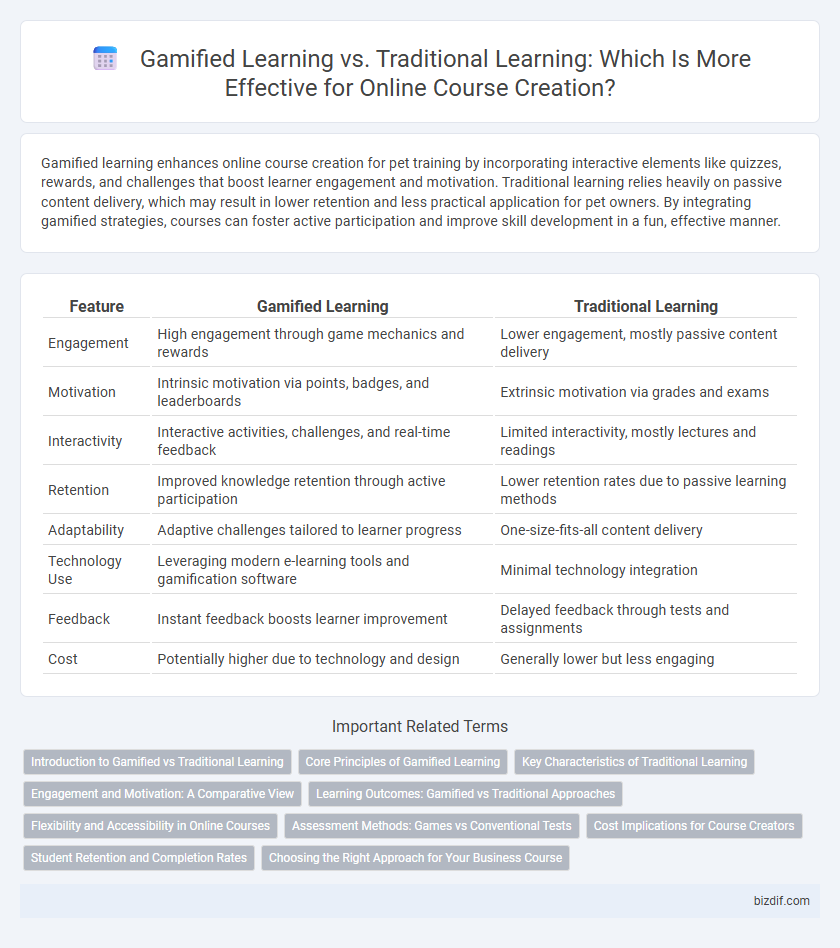Gamified learning enhances online course creation for pet training by incorporating interactive elements like quizzes, rewards, and challenges that boost learner engagement and motivation. Traditional learning relies heavily on passive content delivery, which may result in lower retention and less practical application for pet owners. By integrating gamified strategies, courses can foster active participation and improve skill development in a fun, effective manner.
Table of Comparison
| Feature | Gamified Learning | Traditional Learning |
|---|---|---|
| Engagement | High engagement through game mechanics and rewards | Lower engagement, mostly passive content delivery |
| Motivation | Intrinsic motivation via points, badges, and leaderboards | Extrinsic motivation via grades and exams |
| Interactivity | Interactive activities, challenges, and real-time feedback | Limited interactivity, mostly lectures and readings |
| Retention | Improved knowledge retention through active participation | Lower retention rates due to passive learning methods |
| Adaptability | Adaptive challenges tailored to learner progress | One-size-fits-all content delivery |
| Technology Use | Leveraging modern e-learning tools and gamification software | Minimal technology integration |
| Feedback | Instant feedback boosts learner improvement | Delayed feedback through tests and assignments |
| Cost | Potentially higher due to technology and design | Generally lower but less engaging |
Introduction to Gamified vs Traditional Learning
Gamified learning integrates game design elements such as points, badges, and leaderboards to enhance engagement and motivation in online course creation, contrasting with traditional learning methods that rely on passive content delivery and assessment. Research shows gamification can improve knowledge retention by up to 30% compared to conventional techniques. Online platforms incorporating gamified learning features report higher user completion rates and increased learner satisfaction versus traditional e-learning environments.
Core Principles of Gamified Learning
Gamified learning leverages core principles such as goal orientation, instant feedback, and progressive difficulty to enhance engagement and motivation in online courses. Unlike traditional learning, it integrates game mechanics like points, badges, and leaderboards to foster competition and collaboration among learners. This approach significantly improves retention rates and learner satisfaction by creating an interactive and immersive educational experience.
Key Characteristics of Traditional Learning
Traditional learning relies on structured classroom settings, fixed schedules, and instructor-led lectures emphasizing passive absorption of information. It typically uses standardized assessments and standardized curricula focused on memorization and repetition. This method often lacks interactive elements and real-time feedback that enhance learner engagement and retention.
Engagement and Motivation: A Comparative View
Gamified learning significantly boosts engagement by incorporating game elements such as points, badges, and leaderboards that motivate learners through competition and reward systems. Traditional learning often relies on passive content delivery, which can result in lower motivation and reduced participation. Research shows gamification increases learner retention rates by up to 60% compared to conventional methods, highlighting its effectiveness in online course creation.
Learning Outcomes: Gamified vs Traditional Approaches
Gamified learning enhances engagement and retention by incorporating game mechanics like points, badges, and leaderboards, which motivate learners and improve knowledge application. Traditional learning relies heavily on passive content delivery such as lectures and reading, often resulting in lower interaction and reduced long-term memory retention. Studies show gamified approaches can increase completion rates by up to 50% and improve skill mastery compared to conventional methods.
Flexibility and Accessibility in Online Courses
Gamified learning in online courses enhances flexibility by allowing learners to engage with content at their own pace through interactive challenges and rewards, unlike traditional learning which often follows a fixed schedule. Accessibility improves as gamified platforms support multiple devices and adaptive learning paths, accommodating diverse learning styles and needs. This dynamic approach increases learner motivation and retention, making online education more inclusive and effective.
Assessment Methods: Games vs Conventional Tests
Gamified learning leverages interactive games that provide instant feedback, adaptive challenges, and engaging metrics, enhancing learner motivation and retention. Traditional learning relies on conventional tests like multiple-choice or essay exams, which often emphasize memorization over practical application. Game-based assessments facilitate experiential learning by simulating real-world scenarios, making them more effective in evaluating skills and problem-solving abilities.
Cost Implications for Course Creators
Gamified learning often requires higher initial investment for game design, development, and specialized software, increasing upfront costs for course creators compared to traditional learning formats. However, gamified courses can enhance learner engagement and retention, potentially reducing long-term expenses related to course updates and support. Traditional learning methods typically incur lower development costs but may face higher dropout rates, impacting overall course profitability.
Student Retention and Completion Rates
Gamified learning significantly boosts student retention and completion rates compared to traditional learning by incorporating interactive elements, rewards, and immediate feedback that increase engagement and motivation. Studies reveal courses using gamification see completion rates improve by up to 30%, while traditional methods often suffer from lower retention due to passive content delivery. Enhanced learner involvement through gamified techniques leads to deeper knowledge retention and reduces dropout rates in online course environments.
Choosing the Right Approach for Your Business Course
Gamified learning increases engagement by incorporating game mechanics such as points, badges, and leaderboards, which enhance motivation and retention in online business courses. Traditional learning, relying on lectures and quizzes, offers structured content delivery but may lack interactivity, potentially reducing learner involvement. Selecting the right approach depends on target audience preferences, course objectives, and desired outcomes like improved knowledge retention or skill application.
Gamified Learning vs Traditional Learning Infographic

 bizdif.com
bizdif.com